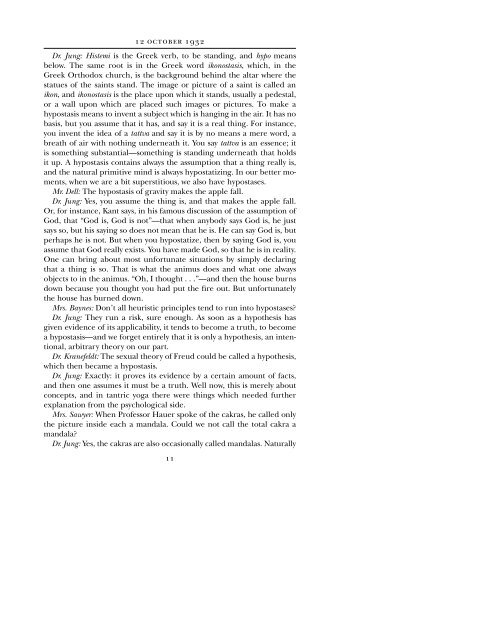CG JUNG - Countryside Anarchist
CG JUNG - Countryside Anarchist
CG JUNG - Countryside Anarchist
Create successful ePaper yourself
Turn your PDF publications into a flip-book with our unique Google optimized e-Paper software.
12 OCTOBER 1932<br />
Dr. Jung: Histemi is the Greek verb, to be standing, and hypo means<br />
below. The same root is in the Greek word ikonostasis, which, in the<br />
Greek Orthodox church, is the background behind the altar where the<br />
statues of the saints stand. The image or picture of a saint is called an<br />
ikon, andikonostasis is the place upon which it stands, usually a pedestal,<br />
or a wall upon which are placed such images or pictures. To make a<br />
hypostasis means to invent a subject which is hanging in the air. It has no<br />
basis, but you assume that it has, and say it is a real thing. For instance,<br />
you invent the idea of a tattva and say it is by no means a mere word, a<br />
breath of air with nothing underneath it. You say tattva is an essence; it<br />
is something substantial—something is standing underneath that holds<br />
it up. A hypostasis contains always the assumption that a thing really is,<br />
and the natural primitive mind is always hypostatizing. In our better moments,<br />
when we are a bit superstitious, we also have hypostases.<br />
Mr. Dell: The hypostasis of gravity makes the apple fall.<br />
Dr. Jung: Yes, you assume the thing is, and that makes the apple fall.<br />
Or, for instance, Kant says, in his famous discussion of the assumption of<br />
God, that “God is, God is not”—that when anybody says God is, he just<br />
says so, but his saying so does not mean that he is. He can say God is, but<br />
perhaps he is not. But when you hypostatize, then by saying God is, you<br />
assume that God really exists. You have made God, so that he is in reality.<br />
One can bring about most unfortunate situations by simply declaring<br />
that a thing is so. That is what the animus does and what one always<br />
objects to in the animus. “Oh, I thought . . .”—and then the house burns<br />
down because you thought you had put the fire out. But unfortunately<br />
the house has burned down.<br />
Mrs. Baynes: Don’t all heuristic principles tend to run into hypostases?<br />
Dr. Jung: They run a risk, sure enough. As soon as a hypothesis has<br />
given evidence of its applicability, it tends to become a truth, to become<br />
a hypostasis—and we forget entirely that it is only a hypothesis, an intentional,<br />
arbitrary theory on our part.<br />
Dr. Kranefeldt: The sexual theory of Freud could be called a hypothesis,<br />
which then became a hypostasis.<br />
Dr. Jung: Exactly: it proves its evidence by a certain amount of facts,<br />
and then one assumes it must be a truth. Well now, this is merely about<br />
concepts, and in tantric yoga there were things which needed further<br />
explanation from the psychological side.<br />
Mrs. Sawyer: When Professor Hauer spoke of the cakras, he called only<br />
the picture inside each a mandala. Could we not call the total cakra a<br />
mandala?<br />
Dr. Jung: Yes, the cakras are also occasionally called mandalas. Naturally<br />
11


